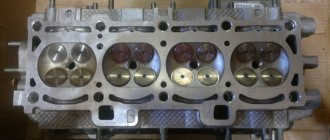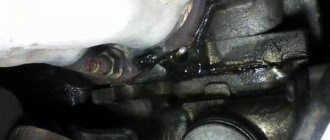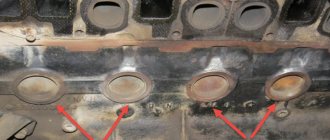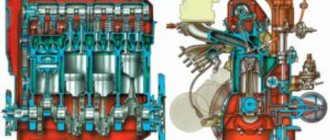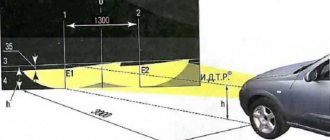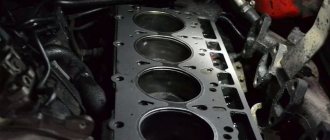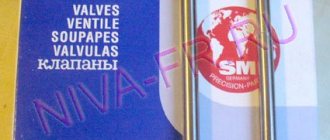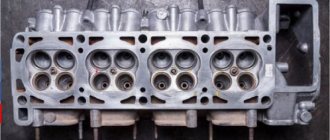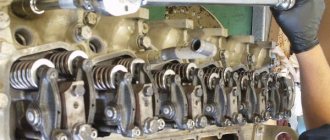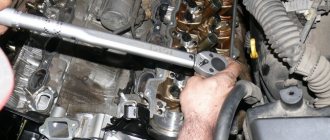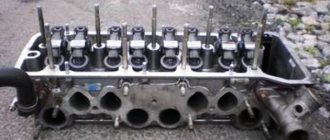Passenger cars are equipped with different types of engines; power units may differ in volume, power, and design.
Depending on the manufacturer, each engine has its own specific resource - the most basic serious failures are considered to be failure of the crankshaft or piston group.
If oil consumption in an engine increases, the most common reason for this is worn or broken piston rings; replacing them is quite labor-intensive work, and also requires certain plumbing skills.
Piston
Cast from aluminum alloy. To improve run-in, the outer surface of the piston (Fig. 5) is coated with a layer of tin. To compensate for uneven thermal expansion, the piston skirt has a complex shape. The piston has a conical shape: the upper part has a smaller diameter than the lower part. Therefore, it is necessary to measure the piston diameter only in a plane perpendicular to the piston pin and at a distance of 52.4 mm from the piston bottom.
The hole for the piston pin is shifted from the axis of symmetry by 2 mm to the right side of the engine. Therefore, in order to correctly install the piston into the cylinder, there is a “P” mark shown in the figure near the hole for the piston pin, which should be facing towards the front of the engine.
According to the outer diameter, the pistons are divided into five classes at 0.01 mm intervals, and according to the diameter of the piston pin hole - into three categories at 0.004 mm. The piston class (letter) and piston pin hole category (number) are indicated on the piston crown.
Spare parts include pistons of classes A, C, E. These classes are sufficient to select a piston for any cylinder, since pistons and cylinders are divided into classes with some overlapping sizes. For example, a class C piston may be suitable for class B and D cylinders. In addition, when repairing engines, pistons are usually replaced on worn cylinders, so a class C piston may be suitable for a slightly worn cylinder that was class B. The main thing when selecting a piston is to ensure the necessary installation gap between the piston and cylinder.
Since 1986, repair size pistons for all engine models have been manufactured with an outer diameter increased by 0.4 and 0.8 mm. Until 1986, pistons of the following repair sizes were produced: for engines 2101 - with an increase of 0.2; 0.4 and 0.6 mm; for 21011 - with an increase of 0.4 and 0.7 mm.
The pistons of engines 2101 and 21011 are easy to distinguish from each other by appearance. In addition to the fact that they have different diameters, the 2101 pistons have a smooth bottom, while the 21011 pistons have a cylindrical recess on the bottom with a diameter of 55 mm and a depth of 1.9 mm.
Selection of spare parts
Before going to the store, you need to roll the car out to a bright place or use a flashlight for work. You need to open the engine compartment cover (hood), approach the car from the left front fender and carefully inspect the left vertical wall of the cylinder block. It is there, in the very center, that the capital Latin letter should be located, indicating the class of the motor.
If the letter is not visible, it means the engine is dirty. You need to clean the surface of the power unit from dirt using a sandblaster and look again. If after this the letter does not appear, it means that it was “eaten” by corrosion. In this case, before going to the auto store, you need to purchase a bore gauge and use this tool to measure the actual dimensions of each cylinder. It happens that some craftsmen do not bore all the cylinders during a major overhaul.
Class A engines that have not been overhauled or bored have cylinders with a diameter of 79 to 79.01 mm, class B - from 79.01 to 79.02, class C - from 79.02 to 79.03, class D - from 79 .03 to 79.04, class E - from 79.04 to 79.05 mm. The original pistons for these blocks have diameters of 78.93, 78.94, 78.95, 78.96 and 78.97 mm, respectively. These are approximate figures, since in reality there is a tolerance of 9 thousandths of a millimeter.
Table of dimensions and tolerances of VAZ classic engine parts
Spare parts stores supply cast pistons of classes A, C and D, intended for unbored engines. Forged pistons for the VAZ 2106 are made to order and come in any size. The main repair dimensions of the VAZ 2106 engine cylinders are 79.4 (first bore) and 79.8 mm (second bore). Piston diameters for the first boring depending on the class (in millimeters):
- A - 79.34.
- B - 79.35.
- C - 79.36.
- D - 79.37.
- E - 79.38.
Piston diameters for the second boring:
- A - 79.74.
- B - 79.75.
- C - 79.76.
- D - 79.77.
- E - 79.78.
It should be noted that pistons are also divided into 3 categories based on the diameter of the piston pin hole, so new pistons must be purchased complete with pins. It is very difficult for a non-professional to distinguish a bored block from an unbored one, so if you are doing major engine repairs yourself, you must definitely purchase a bore gauge, and if this is not possible, then at least take old parts with you and compare them with store-bought parts.
Piston sizes VAZ 2106
The VAZ 2106 car engine is equipped with a piston stroke of 80 (mm) and a compression ratio of 8.5 units.
The main dimensions of the pistons on the VAZ 2106:
An engine piston is a cylindrical part that serves to ensure the tightness of the combustion chamber and convert fuel energy into mechanical work of the engine.
The material for the manufacture of pistons on the VAZ 2106 is an alloy of aluminum and tin.
Piston parameters for VAZ 2106 1.6 MT:
- Piston stroke: 80 (mm);
- Compression ratio: 8.5;
- Piston diameter: 78.93 – 78.97 (mm);
- Years of production: 1976 – 2006.
Important: some modifications of this model, for example, the VAZ 21063 1.3 MT, have a 66 (mm) stroke piston installed.
Other names:
The 4-door sedan VAZ 2106 was also produced under the names VAZ 1600 and Lada 1600.
Years of production: 1976-2006.
It remained the best engine in the USSR! Why is it worth buying a VAZ-2103 with a triple engine?
Why buy a new LADA if you can buy a VAZ-2103 for 25 thousand rubles.
The day before, motorists came to the conclusion that the “triple” engine of the VAZ-2103, as it was the best engine in the USSR, remained so. Today, this car can be bought for 12,500 - 120,000 thousand rubles, the price depends on: mileage, condition of the body and interior, as well as the power unit.
However, these are not all the reasons why you should buy a VAZ-2103 with a triple engine in 2020. “Why?” they said during the research process.
It is worth noting that the cast-iron block of the “triple” engine contained four cylinders with a diameter of 76 millimeters. In turn, the volume of the unit was 1.5 liters, and the power was 71 horsepower.
This unit consumed nine liters of fuel for every 100 kilometers. For comparison, the modern LADA Granta spends 6.5-9.9 liters per “hundred”. At the same time, the power of the modern unit is not much more, only 98 horsepower.
In addition, the volume of engine oil was 3.75 liters, which made it possible to extend the life of the car from 125 thousand kilometers to 200.
“The simplicity of the motor made it possible to disassemble and reassemble the unit in a matter of hours, and no special education was required to understand all the nuances,” the experts added.
As a result, it is important to note that at one time the “triple” engine was filled with AI-93 gasoline, which was replaced by AI-92. Thanks to this fuel, drivers forgot about misfires, and the power unit operated quietly and did not get on VAZovod’s nerves.
Source
Engine piston rings
In an internal combustion engine (ICE), piston rings (PR) serve as a seal between the cylinder walls (liners) and the piston, due to which compression is created in the cylinders. If you forget to put the PC into the engine during assembly, the engine will not start, since the necessary compression of the working air-fuel mixture will not be ensured.
In passenger cars, three rings are standardly installed on each piston - two compression rings and one oil scraper ring, and oil scraper rings can be stacked, that is, consist of several elements. Compression piston rings (CPRs) are used to create compression in the cylinders and are always made of high-strength cast iron with various additives. The upper CPC has the greatest strength, since it operates in the most severe temperature conditions and experiences maximum loads.
Engine oil piston rings (OPRs) are needed to drain oil from the cylinder walls; if the rings do not perform their function, the engine will consume oil. MPKs can be either cast iron or steel, and cast iron PCs are almost always made in one piece, but steel oil scraper rings can only be assembled (composite). Steel MPC for one cylinder consists of:
- two spring steel rings;
- axial expander;
- radial expander.
Thermal clearance of piston rings
PCs are spring discs with one cut - when installed on the piston, they expand, and in the sleeve they are pressed tightly against its walls. In order to achieve maximum compression of the working mixture, the cylinder walls must be as smooth as possible (without defects), and the shape of the internal cavity must be perfectly round. On the piston, the PCs are placed in special grooves, moreover, they are not seated tightly, and on a cold piston they move freely in the grooves.
Piston rings have thermal clearances:
- between PC and groove;
- at the junction.
The clearances must be certain; if they are larger or smaller than the required value, the piston group will quickly fail. One should take into account the fact that when heated, the metal expands, and if the thermal gap of the PC is too small, the piston group will begin to overheat. With large gaps, tightness is not ensured and power losses occur.
For passenger cars, as a rule, the following clearances are established:
- between the grooves and the PDA - from 0.02 to 0.08 mm (for the upper ring the gap should be slightly larger);
- between grooves and MPC – from 0.05 to 0.06 mm;
- at the junction - from 0.25 to 0.5 mm.
As wear occurs, the gaps in the PC increase, and they should not exceed:
This is interesting: Is it possible to drive a dead person’s car?
Malfunctions and repairs of the VAZ 2103 engine
Engine VAZ 2103 1.5 l. carburetor in-line 4-cylinder with an overhead camshaft, the timing belt of the 2103 engine has a chain drive. The VAZ 2103 engine block is tall, more on that below. The service life of the 2103 engine, with careful operation and timely maintenance, exceeds the 125 thousand km established by the factory and reaches 180-200 thousand km. The main differences between the 2103 engine and the 2101 engine are the increased block height by 8.8 mm from 207.1 mm to 215.9 mm to allow the installation of a crankshaft with an increased piston stroke, thanks to which the engine volume has increased to 1.5 liters. As noted in previous articles, Lada engines have a problem with camshaft wear. Due to the fact that the chain drive does not have a tensioner, the chain needs to be tightened, the engine also needs constant (every 10 thousand km) adjustment of the valve clearances, this will be indicated by a loud knocking sound in the VAZ 2103 engine when the engine is idling, audible from a standstill driver with the hood closed. Many people have a question, why adjust the valves, the answer is simple - power will decrease, fuel consumption will increase, the valve will burn out and many other pleasures of life. Adjustment of the VAZ 2103 engine valves must be done either by a master or with his own hands. Among other problems, Weber and Ozone carburetors constantly require CO adjustment and cleaning. It often happens that the VAZ 2103 engine gets hot, look for the problem in the pump, 99% this is it. Often when the engine in a 2103 misfires, there can be a lot of reasons, most often a burnt-out valve; in any case, you need to measure the compression and show the car to a mechanic. Many VAZ 2103 engine malfunctions repeat the problems of the 2101, due to their close relationship. For a more complete picture and so as not to miss anything, read about the 2101 engine here. Nevertheless, according to popular opinion, the 2103 engine is the most reliable and unpretentious among the classic line of engines, and given the prices for spare parts for the VAZ 2103 engine, you don’t have to wonder why the classics are still driving along our streets.
Selection of piston for VAZ Zhiguli cylinder
- Repair manuals
- Repair manual for VAZ 2107 (Zhiguli) 1982+.
- Selection of piston to cylinder
The calculated gap between the piston and cylinder (for new parts) is 0.05–0.07 mm. It is determined by measuring the cylinders and pistons and is ensured by installing pistons of the same class as the cylinders . The maximum permissible gap (if parts are worn) is 0.15 mm.
| Rice. 3–25. Main dimensions of piston, connecting rod, piston pin and piston rings |
NOTE
The piston diameter is measured in a plane perpendicular to the piston pin, at a distance of 52.4 mm from the piston crown (see
).
According to the outer diameter, the pistons are divided into five classes (A, B, C, D, E) every 0.01 mm, and according to the diameter of the piston pin hole - into three categories every 0.004 mm.
The piston class (letter) and the piston pin hole category (number) are stamped on the piston bottom .
If a used engine has a gap exceeding 0.15 mm, then it is necessary to re-select the pistons to the cylinders so that the gap is as close as possible to the calculated one.
Spare parts include pistons of classes A, C, E. These classes are sufficient to select a piston for any cylinder, since pistons and cylinders are divided into classes with some overlapping sizes.
↓ Comments ↓
1. Vehicle operation and maintenance
1.0 Operation and maintenance of the vehicle 1.1. Vehicle operation 1.2 Vehicle maintenance
2. General information
2.0 General data 2.1 Technical characteristics of vehicles 2.2 Controls and monitoring devices 2.3. Ventilation control and interior heating
3. Engine
3.0 Engine 3.1 Removal and installation of the engine 3.2 Disassembling the engine 3.3 Possible engine malfunctions, their causes and methods of elimination 3.4 Engine assembly 3.5 Bench tests of the engine 3.6 Checking the engine on a car 3.7. Cylinder block 3.8. Pistons and connecting rods 3.9. Crankshaft and flywheel 3.10. Cylinder head and valve mechanism 3.11. Camshaft and its drive 3.12. Cooling system 3.13. Lubrication system 3.14. Supply system
4. Transmission
4.0 Transmission 4.1. Clutch 4.2. Gearbox 4.3. Cardan transmission 4.4. Rear axle
5. Chassis
5.0 Chassis 5.1. Front suspension 5.2. Rear suspension 5.3. Shock absorbers
6. Steering
6.0 Steering 6.1. Inspection, check and adjustment of steering 6.2. Steering mechanism 6.3. Steering rods and ball joints 6.4. Swing arm bracket
7. Brakes
7.0 Brakes 7.1. Checking and adjusting the brakes 7.2 Possible malfunctions of the brakes, their causes and methods of elimination 7.3 Bracket for the clutch and brake pedals 7.4. Vacuum booster 7.5. Brake master cylinder 7.6. Front brakes 7.7. Rear brakes 7.8. Rear brake pressure regulator 7.9. Parking brake
8. Electrical equipment
8.0 Electrical equipment 8.1 Electrical equipment diagram 8.2. Battery 8.3. Generator 8.4. Starter 8.5. Ignition system 8.6. Lighting and light signaling 8.7. Sound signals 8.8. Windshield cleaner 8.9 Headlight cleaner 8.10. Heater electric motor 8.12. Control devices
9. Body
9.0 Body 9.1. Doors 9.2 Possible body malfunctions, their causes and methods of elimination 9.3. Hood, trunk lid, bumpers 9.4. Body glazing 9.5. Windshield and headlight glass washers 9.6. Instrument panel 9.7. Seats 9.8. Heater and ventilation of the body interior 9.9. Body frame repair 9.10. Paint and varnish coatings 9.11. Anti-corrosion protection of the body
10. Modification and equipment of VAZ-2107 cars
10.0 Modification and equipment of VAZ-2107 vehicles 10.1. Car VAZ-21072 10.2 Car VAZ-21074 10.3. Car VAZ-21073-40
11. Applications
11.0 Appendices 11.1 Appendix 1. Tightening torques for threaded connections* 11.2 Appendix 2. Tools for repair and maintenance* 11.3 Appendix 3. Used fuels and lubricants and operating fluids 11.4 Appendix 4. Basic data for adjustment and control 11.5 Scheme
What engine can be installed on a VAZ 2103 instead of the standard one?
Domestic cars are good because with a sufficient budget it will be possible to implement almost any planned project. Even when connecting the engine to the gearbox there are no particular difficulties. Thus, almost any power unit is suitable for the VAZ 2103. The main thing is that it must fit in size.
Rotary engine
Until a certain time, only special police forces and the KGB were armed with cars with such engines. However, tuning enthusiasts in the USSR, folk craftsmen, found and installed a rotary piston engine (RPE) on their VAZ 2103.
The RPD can be easily installed on any VAZ car. It goes to Moskvich and Volga in a three-section version.
The rotary piston engine can be easily installed on any VAZ car
Diesel engine
The diesel engine is mated to the standard VAZ 2103 gearbox using an adapter plate, although the gear ratios of the engines are not at all suitable.
- Driving with a diesel Volkswagen Jetta Mk3 will not be very comfortable, especially after 70–80 km/h.
- The option with a diesel unit from the Ford Sierra is a little better. In this case, you will have to change the design of the tunnel, install a gearbox from a BMW and make some other changes.
Motors from foreign cars
In general, foreign-made engines have been and are often installed on the VAZ 2103. True, it is impossible to avoid additional modifications in this case.
- The most popular engine is the Fiat Argenta 2.0i. About half of the owners of tuned “threes” installed these engines. There are practically no problems with installation, however, the engine is a bit old, which is unlikely to please the owner.
- Engines from BMW M10, M20 or M40 are also suitable. We have to modify the struts, rework the flywheel and replace the axles.
- Engines from Renault Logan and Mitsubishi Galant are praised by craftsmen, but in these cases the gearbox has to be changed.
- And, probably, the best option is the power plant from Volkswagen 2.0i 2E. True, such an engine is not cheap.
Engine repair
The easiest way to repair a power plant is to replace consumables. However, real restoration of the internal combustion engine involves its removal, disassembly and subsequent installation.
Before you begin the operation, it is important to prepare the correct tools.
How to remove the engine
Now you will need to prepare protection for the body - install a wooden block between the engine and the body. He will insure in case of possible damage.
Replacing earbuds
They are thin semicircular plates of steel, and are cages for bearings.
The earbuds cannot be repaired as they have a fixed size. Parts have to be replaced due to physical wear and tear, as over time the surfaces wear out and a backlash appears, which is important to eliminate in a timely manner. Another reason for replacement is rotation of the liners.
Replacing piston rings
The entire procedure for replacing piston rings comes down to three steps:
If you have a puller, removing old rings from the piston will not cause any difficulties. If you don’t have a tool, you can try using a thin screwdriver to open the ring and remove it. First of all, the oil scraper ring is removed, then the compression ring.
New rings must be inserted using a special mandrel or crimp. Today they are sold in any auto store.
Oil pump repair
The oil pump is the most important component of the VAZ 2103 engine lubrication system. With its help, lubricant is pumped from the crankcase through all channels. The first sign of a pump malfunction is a decrease in pressure, and the cause is a clogged oil receiver and a clogged crankcase.
Oil pump repair involves draining the oil, removing the pan and washing the oil receiver. Other causes of unit failure include a broken pump housing. To restore the part, special tools are used, such as an impact driver, a soldering iron, a set of wrenches and a screwdriver.
Video: about repairing the VAZ 2103 engine
The VAZ 2103 engine and its modifications are considered one of the best in the class. However, over time they also require repairs and replacement of components.
Source
Other parameters of VAZ 2106:
| vaz 2106 pistons – detailed dimensions |
| General parameters of VAZ 2106 pistons | |
| Drawing General General view of the pistons | Models Total number of models presented |
| Modifications The total number of all modifications of all VAZ models presented in our database | ||
| (drawing) | 5 units | 10 units |
| VAZ 2106 pistons parameters |
| Parameter Piston parameter |
Data is presented in millimeters (mm)
Caution: the above data are the official figures of the manufacturer, however, please note that the information is for reference only and does not guarantee absolute accuracy.
Source: razmery.info
Maintenance schedule
The official manual explains the design of the internal combustion engine and the timing of replacing consumables when servicing the engine:
| Maintenance object | Time or mileage (whichever comes first) |
| Timing belt | replacement after 100,000 km |
| Battery | 1 year/20000 |
| Valve clearance | 2 years/20000 |
| Crankcase ventilation | 2 years/20000 |
| Belts that drive attachments | 2 years/20000 |
| Fuel line and tank cap | 2 years/40000 |
| Motor oil | 1 year/10000 |
| Oil filter | 1 year/10000 |
| Air filter | 1 – 2 years/40000 |
| Fuel filter | 4 years/40000 |
| Heating/Cooling Fittings and Hoses | 2 years/40000 |
| Coolant | 2 years/40000 |
| Oxygen sensor | 100000 |
| Spark plug | 1 – 2 years/20000 |
| Exhaust manifold | 1 year |
Thanks to its simple design, oil changes and even major repairs can be done yourself. In Soviet times, car enthusiasts practiced engine modernization, the options for which are discussed below.
Lightening the VAZ crankshaft
We have already written about how to lighten a flywheel, but a flywheel alone is of little use. In this article we will look at lightening the crankshaft and other parts of the crankshaft.
Lightening the VAZ crankshaft:
For a standard crankshaft, you can also make it lighter; it has a large margin of safety. But this must be done after weighing all the pros and cons.
So the advantages of crankshaft lightening:
- Inertial masses, which negatively affect the crankshaft journals, are reduced, increasing their wear
- The motor is lighter and revs faster
Disadvantages of relief:
- If the crankshaft is lightened incorrectly or excessively, idle performance may deteriorate, and under high loads the crankshaft may simply burst.
- Additional costs for tuning (well, how could we do without it?)
Lightening the crankshaft consists mainly of machining the cheeks and counterweights. There is no single scheme for lightening the crankshaft. Someone mills the sides of the cheeks, someone sharpens the counterweights, sometimes even very sharply, someone simply brings the cast surface to good cleanliness, removing casting defects, grinding and polishing the surface of the knee.
But it's not that simple. After any intervention in the design of the crankshaft, preferably even after grinding the journals, it is necessary to balance it.
Static balancing is not suitable here as for a flywheel; dynamic balancing is needed here, using special equipment.
True, there are masters who can balance you on their homemade stands, but mostly it’s all of poor quality.
It is not worthwhile to greatly lighten the crankshaft counterweights, since they are strongly interconnected with the weight of the journal and connecting rod, so that the counterweight will not be much lighter than the journal. Lightening the crankshaft by more than 1 kg is dangerous.
I remind you once again that after lightening the crankshaft, dynamic balancing is mandatory.
See how the crankshaft is lightened. The picture shows the Nadezhda crankshaft; for other VAZ models everything is similar.
I wish you success!
VAZ piston rings
The Volzhsky Automobile Plant produces engines for front-wheel drive and rear-wheel drive cars; piston rings for VAZ engines were originally supplied by the Michurinsky plant. The Michurins produced a lot of defects in their products, and since 1986, their own production was established in Tolyatti. Currently, there are many different manufacturers that produce PCs for VAZ engines, in particular, these are:
- AVTOVAZ (Tolyatti);
- STK (Samara);
- GOETZE (Germany);
- MAHLE (Germany);
- NPR EUROPE (formerly SM, Japan).
Signs and causes of wear (breakage) of piston rings
On VAZ cars, the engine wears out during operation, and the PCs also fail. Rings can:
- break into two or more parts;
- wear out in thickness;
- have general wear and tear.
Parts often break down due to overheating of the internal combustion engine; in this case, compression in the cylinders decreases and the engine loses power. Signs of a faulty PC are:
- bluish smoke from the muffler pipe, especially often it appears after a long period of idling when the gas pedal is sharply pressed;
- increased engine oil consumption;
- drop in power, the motor stops pulling;
- coking of spark plugs.
If there are signs of a malfunction in the piston group, the piston rings are replaced first. But replacing a PC does not always give the desired effect; often after repair the engine continues to smoke and consume oil. The reason for this is simple - there is wear in the cylinders themselves. In the block, the liners usually wear out unevenly - they take on an oval shape; due to wear, the piston rings do not fit tightly to the cylinder walls and do not provide a tight seal.
Pistons and connecting rods.VAZ-— DRIVE2
Pressing out the piston pin.
Selection of piston to cylinder.
The calculated gap between the piston and cylinder (for new parts) is 0.025-0.045 mm. It is determined by measuring the parts and is ensured by installing pistons of the same class as the cylinders. The maximum permissible gap (if parts are worn) is 0.15 mm. If a used engine has a gap exceeding 0.15 mm, then it is necessary to reselect the pistons so that the gap is as close as possible to the calculated one. Spare parts include pistons of classes A, C, E. This is enough to select a piston for any cylinder during engine repair, since pistons and cylinders are divided into classes with a slight overlap of sizes. For example, a class C piston may be suitable for class B and D cylinders. A class C piston may also be suitable for worn class A and B cylinders.
Disassembly.
Remove the piston rings. Place the piston in the support with a cylindrical recess and press out the pin using mandrel A.60308 (Fig. 2-32). If some parts of the connecting rod and piston group are not damaged and have little wear, they can be used again. Therefore, when disassembling, mark them in order to later assemble a group with the same parts and install them in the same cylinder. Assembly. Before assembly, fit the pin to the piston. For proper pairing, it is necessary that the piston pin, lubricated with engine oil, enters the piston hole by simply pressing it by hand (Fig. 2-33) and does not fall out if the piston is held as shown in Fig. 2-34. Replace the finger that falls out with another one of the next category. If the third category pin falls out of the piston hole, replace the piston and repeat the selection of the pin.
Since the pin is inserted into the upper head of the connecting rod with interference, it is necessary to heat the connecting rod to expand its head. To do this, place the connecting rods for 15 minutes in an electric oven heated to 240°C. Prepare the finger for assembly in advance by placing it on the shaft of device A.60325 with spacer ring 5 installed. The ring should have a thickness of 4 mm, an outer diameter of 22 mm and an inner diameter of 15 mm. At the end of the device, a guide 3 is installed, secured with a screw 4. Tighten the screw loosely so that jamming does not occur when the pin expands from contact with the heated connecting rod. To properly connect the pin to the connecting rod, press in the pin as soon as possible, since the connecting rod cools quickly and after cooling it will be impossible to change the position of the pin. The piston and connecting rod must be assembled so that the arrow on the piston bottom is directed towards the oil outlet hole (if equipped) on the lower end of the connecting rod (see Fig. 2-31). Quickly clamp the connecting rod removed from the oven in a vice. When putting the piston on the connecting rod, make sure that the hole for the pin coincides with the hole in the upper head of the connecting rod. Push the piston pin attached to the device into the piston hole and the upper head of the connecting rod (Fig. 2-36) until the shoulder of the device stops in the piston. During this operation, the piston must be pressed by the boss against the upper head of the connecting rod in the direction of pressing the pin (shown by the arrow in Fig. 2-36). Then the finger will take the correct position. After the connecting rod has cooled, lubricate the pin with engine oil through the holes in the piston bosses. Lubricate the piston grooves, piston rings and
Flywheel
The part is cast iron with a steel ring gear that is connected to the starter gear. Pressing of the crown is done using the hot method. The teeth are thoroughly hardened by high frequency currents.
The flywheel is secured using 6 self-locking bolts. The location of the clamps has only two positions according to the marks. Centering of the flywheel with the crankshaft is carried out through the front bearing of the gearbox drive shaft.
Main technical characteristics:
| Engine capacity | 1450 cm3 |
| Power | 75 hp |
| Torque | 104/3400 nm |
| Gas distribution mechanism | HE IS WITH |
| Number of cylinders | 4 |
| Number of valves per cylinder | 2 |
| Cylinder diameter | 76 mm |
| Piston stroke | 80 mm |
| Compression ratio | 8.5 |
Engine characteristics 2103
Years of manufacture – (1972 – present time) Cylinder block material – cast iron Power system – carburetor/injector Type – in-line Number of cylinders – 4 Valves per cylinder – 2 Piston stroke – 80 mm Cylinder diameter – 76 mm Compression ratio – 8.5 Engine displacement 2103 – 1452 cm3 Engine power 2103 – 71 hp. /5600 rpm Torque - 104 Nm / 3400 rpm Fuel - AI93 Fuel consumption - city 9.4l. | track 6.9 l. | mixed 8.9 l/100 km Oil consumption - 700 g per 1000 km Weight of the VAZ 2103 engine - 121 kg Overall dimensions of the 2103 engine (LxWxH), mm - 565x541x665 Oil for the VAZ 2103 engine: 5W-30 5W-40 10W-40 15W-40 How much engine oil 2103: 3.75 l. When replacing, fill in about 3.5 liters.
VAZ 2103 engine life: 1. According to the plant – 125 thousand km 2. In practice – up to 250 thousand km
Tuning Potential – 200 hp Without loss of resource - 80 hp.
The engine was installed on: VAZ 21023 VAZ 2103 VAZ 21043 VAZ 21053 VAZ 21061 VAZ 2107

